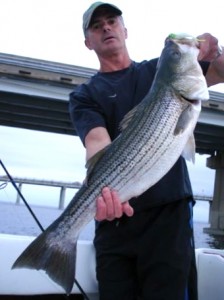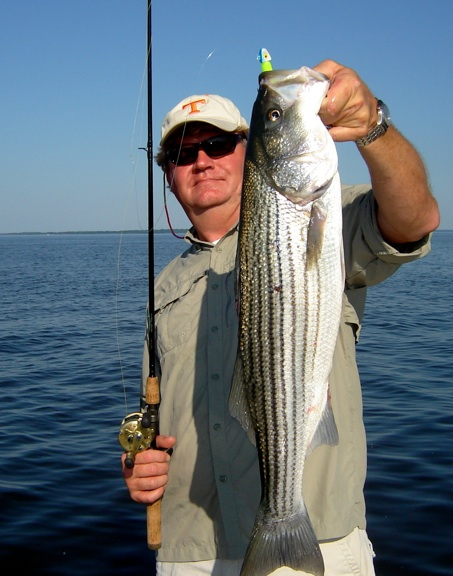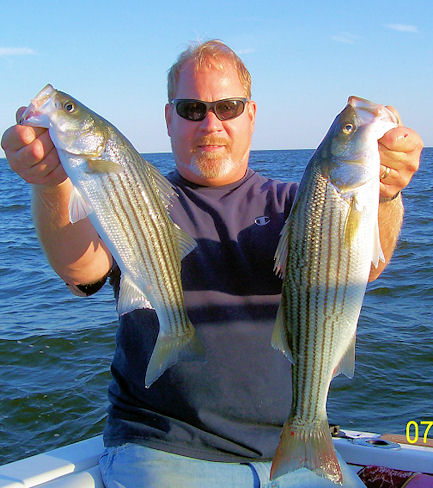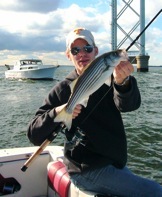tips & tricks
 Big fish are rare in mid-September, so it’s somewhat surprising that we’re turning up a few. I’ve had at least one fish over thirty inches long in each of my last six jigging trips to the Bay Bridge. As long as that’s happening, there’s no need to fish anywhere but right here at home. I made it out to the bridge the past three evenings. The water has cooled to the mid-70s and the recent unsettled weather has the fish thinking about feeding up for the winter. Tuesday, my friend Rich was nice enough to pick me up below the bridge on my way home from work. The tide was slack when we started, but picked up to a strong flow just before dark. We broke the 30 inch mark on two fish, lost a couple more when they wrapped around the pilings and broke off, and I hooked into something huge and slow. It might have been a skate, but it felt more like a fish, possibly a big drum. Read More!
Big fish are rare in mid-September, so it’s somewhat surprising that we’re turning up a few. I’ve had at least one fish over thirty inches long in each of my last six jigging trips to the Bay Bridge. As long as that’s happening, there’s no need to fish anywhere but right here at home. I made it out to the bridge the past three evenings. The water has cooled to the mid-70s and the recent unsettled weather has the fish thinking about feeding up for the winter. Tuesday, my friend Rich was nice enough to pick me up below the bridge on my way home from work. The tide was slack when we started, but picked up to a strong flow just before dark. We broke the 30 inch mark on two fish, lost a couple more when they wrapped around the pilings and broke off, and I hooked into something huge and slow. It might have been a skate, but it felt more like a fish, possibly a big drum. Read More!
 I mentioned in an earlier “How-To” article that I would write about interesting jigging situations when I encountered them. We’re in the middle of some amazing summer fishing. I’ve been chasing breakers over hard bottoms on both sides of the Bay. This is a typical Chesapeake hot-weather pattern which will usually last and even intensify until fall.
I mentioned in an earlier “How-To” article that I would write about interesting jigging situations when I encountered them. We’re in the middle of some amazing summer fishing. I’ve been chasing breakers over hard bottoms on both sides of the Bay. This is a typical Chesapeake hot-weather pattern which will usually last and even intensify until fall.
The challenge presented by blitzing fish is not in finding the right lure. Almost any lure will catch when fish are in a wild surface-feeding frenzy. I’ve caught rock and blues with a bare hook using only a cut-off piece of a pink soda-straw for bait. I know other fishermen who routinely use a church-key can-opener with attached hooks as a fishing lure for casting into breakers. When working a blitz, the difficult part comes in getting larger fish, especially keeper-size stripers out of the schools. Read More!
 Just when I thought the western shore was going to turn into the Summer striped bass hotspot, the fish showed up back over on the east side last night. Tim & Mike joined me on Crockett’s Reel for a 5:30 PM launch from Shipping Creek on Kent Island. We buzzed the Eastern Bay stopping only once when a flock of diving least terns alerted us to bait, then continued through Poplar Narrows south to an area that occasionally holds fish this time of year. My original plan was to cruise on across to the oyster flats off Chesapeake Beach, but it was soon apparent we had traveled far enough.
Just when I thought the western shore was going to turn into the Summer striped bass hotspot, the fish showed up back over on the east side last night. Tim & Mike joined me on Crockett’s Reel for a 5:30 PM launch from Shipping Creek on Kent Island. We buzzed the Eastern Bay stopping only once when a flock of diving least terns alerted us to bait, then continued through Poplar Narrows south to an area that occasionally holds fish this time of year. My original plan was to cruise on across to the oyster flats off Chesapeake Beach, but it was soon apparent we had traveled far enough.
A few seagulls over a steep drop-off put us on a some small bluefish. As we were playing around with them and watching the fishfinder, bigger marks showed up. Stacked fish near the bottom is usually a sign of rockfish. We all three hooked up about the same time with some respectable summer fish. Read More!
 Following up the previous article on basic vertical jigging techniques, I want to share what I know for kicking it into the next gear. Most of these methods are a natural progression from vertical jigging. Jigging is an extremely productive method for catching Chesapeake Bay rockfish, so it’s something you’ll want to practice and learn well.
Following up the previous article on basic vertical jigging techniques, I want to share what I know for kicking it into the next gear. Most of these methods are a natural progression from vertical jigging. Jigging is an extremely productive method for catching Chesapeake Bay rockfish, so it’s something you’ll want to practice and learn well.
Most of my techniques have been honed over time by bass & striper fishing in fresh water situations. Bay fishing is similar in many respects, but there some special considerations.
The Chesapeake Bay is very shallow compared to many striped bass environments. While suspended fish are occasionally encountered, it’s more likely that they are either feeding on the surface or holding near the bottom. Read More!


